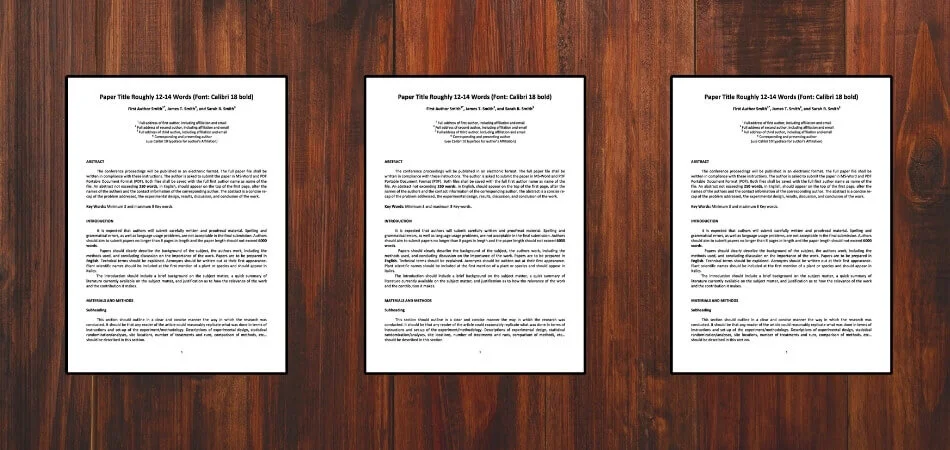Crafting a compelling conference paper can be a significant moment for academics and professionals alike. The key question that often arises is, “What should a conference paper contain?”
A well-structured conference paper typically encompasses several crucial elements: an abstract to give a snapshot of your work, a clear and concise title, an introduction that sets the stage, clearly defined objectives, a detailed methods section to elucidate your approach, comprehensive results or findings, a thoughtful discussion of these findings, and a conclusion that offers meaningful recommendations.
Additionally, acknowledgments and references are essential to give credit where it’s due. If you’re keen on mastering the art of conference paper writing, our blog delves deeper into each of these elements, guiding you through the process of creating a paper that stands out in any academic or professional setting.
What is a Conference Paper?
A conference paper is an academic work presented at a professional or academic conference. It’s a crucial platform for researchers and scholars to share their latest findings and insights. These papers contribute significantly to the pool of academic knowledge, creating collaboration and discourse in various fields.
Typically, a conference paper includes comprehensive research findings or theoretical analyses. It’s structured to provide a clear overview of the research question, methodology, and results. The impact of conference papers is significant, as the aim is to incite discussion among peers, seek feedback, and support advancements in the subject area. Conference papers often serve as precursors to more detailed articles in academic journals, offering a snapshot of ongoing research.
Significance of the Conference Paper
In academic and professional development conferences, the conference papers hold a vital role. They act as a medium for scholars and professionals to disseminate new research and ideas. This form of academic writing is vital in promoting a collaborative and progressive environment in various fields.
- Conference papers provide a platform for presenting new research findings, allowing immediate feedback and discussion. They offer a unique opportunity for researchers to test their ideas in a knowledgeable community.
- They act as a catalyst for networking and collaboration, connecting like-minded professionals and academics. This interaction often leads to future research partnerships and advancements in the field.
- These papers contribute to the global repository of knowledge by featuring in conference proceedings. They serve as accessible references for ongoing and future research in respective fields.
- Conference papers also aid in professional development, enhancing the visibility and credibility of researchers. Presenting at conferences can open doors to academic recognition and career opportunities.
Conference papers are more than just documents; they are dynamic tools for knowledge exchange, networking, and professional growth. They remain crucial in the ever-evolving landscape of research and academic discourse.
What Should a Conference Paper Contain?
Crafting a conference paper is an art that blends rigorous research with concise communication. It’s a document that showcases a researcher’s work in a structured and engaging manner. Being aware of the key components of a conference paper is crucial for academic success. Here are the key components of a conference paper:
Abstract
The abstract is a succinct summary of your paper, offering a snapshot of your research. It should clearly outline the purpose, methodology, results, and significance of your study. This condensed version entices readers to delve deeper into your work.
An effective abstract is both informative and engaging. It should encapsulate the essence of your research, providing a clear overview. Crafting a compelling abstract is significant, as it often determines whether the audience will read the rest of your paper.
Introduction
The introduction sets the stage for your research, outlining the context and significance of your study. It should present the research question or hypothesis and indicate why this study is important. This section primes the reader for the detailed content that follows.
It’s crucial to hook the reader’s interest in the introduction. Provide enough background to make your research accessible to a broad audience. Your introduction should bridge the gap between your research and the reader’s understanding.
Methodology
In the methodology section, detail the procedures and techniques used in your research. This part provides transparency and allows others to replicate your study. It’s essential for validating the reliability of your findings.
Describe your approach, data collection methods, and analysis techniques. This clear description ensures that your research process is understood and credible. Your methodology should be thorough yet concise, providing all necessary details.
Results and Discussion
Here, you present the findings of your study in a clear, logical manner. This section should be straightforward, focusing on what the data reveals. It’s the heart of your paper, where your research comes to life.
The discussion interprets your results, explaining their significance in the broader context. This is where you connect your findings to existing knowledge and theories. Your discussion should be insightful, offering a deeper perception of your study’s implications.
Conclusion and Future Directions
The conclusion summarizes the key findings and their implications. It should restate the significance of your research, highlighting its contribution to the field. This is where you bring your paper to a cohesive end.
Also, suggest future research directions, based on your findings. This gesture shows the ongoing relevance of your work and invites further exploration. Your conclusion should leave the reader pondering the broader impact of your study.
A well-structured conference paper is a blend of clarity, precision, and insight. It not only presents research findings but also contributes to the ongoing dialogue in its field. Crafting such a paper requires careful attention to each section, ensuring that the whole is greater than the sum of its parts.
How to Write a Conference Paper Properly?
Writing a conference paper is a strategic process, blending research with formal academic writing. Crafting a strong conference paper for attending international conference is an opportunity to present your work to a broader audience and contribute to your field. A structured approach is required to complete this task effectively.
Begin by familiarizing yourself with the theme and guidelines of the conference. This ensures your paper aligns with the event’s focus and audience. Customizing your content to these parameters is crucial for acceptance and engagement. Choose a topic that is both relevant to your field and interesting to you. Ensure it aligns with the conference theme and contributes new insights. A good topic is the foundation of a successful conference paper.
Engage in comprehensive research to support your paper. This includes reviewing existing literature and conducting your investigations. Solid research underpins your arguments and increases the credibility of your paper. Create a detailed outline, organizing your main points logically. This serves as a roadmap for your paper, ensuring a coherent flow of ideas. A well-structured outline simplifies the writing process.
Your abstract should succinctly summarize your paper, including the problem, methods, results, and conclusion. It’s the first impression of your work, so make it impactful and concise. Introduce your topic, stating the research problem and its significance. Provide enough background to orient the reader. A strong introduction sets the tone for your paper. Explain the methods used in your research clearly and concisely. This section should enable others to replicate your study. Transparency in methodology is key to a paper’s credibility.
Showcase your findings in a clear and organized manner. Use tables, graphs, and charts for clarity if needed. The results section should be factual and straightforward. Interpret your results, linking them to your hypothesis and existing research. Discuss the implications and limitations of your findings. This section adds depth and context to your paper.
Summarize the key points and their importance. State the contribution of your research to the field. End with suggestions for future research, highlighting the ongoing relevance of your topic. Thoroughly revise your paper for clarity, coherence, and academic tone. Pay attention to the conference’s formatting guidelines. A well-edited paper is more likely to be accepted and respected.
Conference Paper Writing Considerations
The process of writing a conference paper requires careful consideration and precision. Research isn’t just about presenting findings, but engaging an audience and contributing to scholarly discourse. To write a successful paper, clarity, relevance, and scholarly rigor must be balanced. Here are a few things you should consider while writing:
Aligning with Conference Themes
Ensure your paper aligns with the conference’s theme and objectives. This relevance is critical for acceptance and audience engagement. Customize your topic and content to resonate with the conference’s focus.
Avoid straying too far from the central theme. A well-aligned paper improves the overall coherence of the conference. Your research should contribute meaningfully to the overarching dialogue of the event.
Clarity and Conciseness
Aim for clarity and conciseness in your writing. The standard length of a short conference paper typically ranges from 4 to 6 pages, so every word counts. Complex ideas should be communicated in an accessible manner. This clarity ensures that your research is understood by a diverse audience. Avoid unnecessary jargon and overly complex sentences. Your goal is to convey information effectively, not to impress with convoluted language. A clear and concise paper is more likely to engage and inform your audience.
Methodological Rigor
Your methodology should be robust and transparent. This rigor ensures the credibility and replicability of your research. A clear methodology section is fundamental for peer review and discussion. Include sufficient detail for others to understand and potentially replicate your study. However, balance this with the need for conciseness. Your methodology should be thorough yet succinct.
Engaging Presentation of Data
Present your data engagingly and clearly. Use visuals like charts and graphs where appropriate. These tools can better understand and retain complex information. Ensure that any visual aids are relevant, clear, and professionally presented. They should complement, not overwhelm, your verbal presentation. Effective data presentation can significantly impact the reception of your paper.
Critical Analysis and Discussion
Provide a critical analysis of your findings. Discuss their implications in the broader context of your field. This depth of analysis demonstrates the significance of your work. Avoid merely presenting data without interpretation. Your discussion should offer insights and connect your research to existing knowledge. It’s where you demonstrate the value and originality of your work.
Frequently Asked Questions
In this section, we address common queries regarding what a conference paper should contain. Knowing these key components will help you craft a well-structured and effective paper. Whether you’re a first-time author or looking to improve your writing, these answers will guide you in preparing for your conference presentation.
What Are the Main Components of a Conference Paper?
A conference paper typically includes several main components. These include an introduction, methodology, results, discussion, and conclusion. The introduction sets the stage by presenting the research problem and objectives. The methodology outlines how the research was conducted, while the results and discussion provide insights into the findings and their implications.
How Important Is the Abstract in a Conference Paper?
The abstract is a critical component of a conference paper, as it summarizes the main points in a concise format. It usually appears at the beginning and helps readers quickly grasp the research’s purpose and significance. A well-written abstract can attract the interest of conference attendees and reviewers. Therefore, it’s essential to ensure that your abstract reflects the paper’s content and contributions.
Should I Include References in My Conference Paper?
Yes, including references in your conference paper is vital for acknowledging the work of others and providing context for your research. Citing relevant literature demonstrates your knowledge of the field and supports your findings. Make sure to follow the citation style required by the conference. A comprehensive reference list can increase the credibility of your work.
How Long Should Each Section Be in a Conference Paper?
The length of each section in a conference paper can vary depending on the total word count and specific guidelines from the conference. However, a general rule of thumb is to allocate about 10-15% of the total length to the abstract, 25-30% to the introduction, and the remaining sections proportionally based on complexity. Keeping each section concise while ensuring clarity is essential. Always refer to the conference guidelines for any specific length requirements.
Is a Conclusion Necessary in a Conference Paper?
Yes, a conclusion is an essential part of a conference paper. It summarizes the key findings and contributions of your research, highlighting its significance in the field. The conclusion also provides an opportunity to suggest future research directions or practical applications of your findings. Including a strong conclusion can leave a lasting impression on your audience.
Final Words
A conference paper must start with a clear, concise abstract, followed by an introduction that effectively sets the context. The methodology section needs to be detailed yet straightforward, ensuring replicability. Results and discussions should be presented in a manner that highlights the significance of the findings.
The conclusion should encapsulate the essence of the research, offering insights and future directions. Throughout, the paper must maintain methodological rigor and an analytical approach, ensuring that it contributes valuably to the academic discourse.
Errors in these aspects can lead to misunderstandings or misinterpretations of the work, underscoring the importance of meticulousness in answering “What should a conference paper contain?” This approach not only ensures the accuracy and integrity of the paper but also improves its impact on the academic community.








